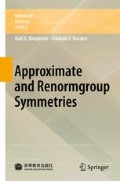Abstract
The notion “RenormGroup Symmetry” (RGS) originated in mathematical physics at the beginning of the nineties [8] (see also reviews [12, 13, 14]) as a result of joining up the notion “symmetry group” as applied to differential equations and “renormgroup”, i.e., symmetry group of a particular solution. In its turn, the notion of Renormalization Group, or briefly RenormGroup (RG), was imported to mathematical physics from theoretical physics, namely from quantum field theory [16, 17, 4, 1]. In quantum field theory renormgroup was based upon finite (Dyson) transformations and appeared as a continuous group in a usual mathematical sense. This group was then successfully used in developing a regular method of improving approximate perturbation solutions, the renormgroup method [2, 3]. In transferring renormgroup concept to mathematical physics problems [8] the aim was ultimately the same as in quantum field theory — to improve the perturbation theory solutions and to correct the behavior of these solutions in the vicinity of a singularity. In mathematical physics we usually deal with the problems, based on systems of differential equations or integro-differential equations, the symmetry of which can be found using computational methods of modern group analysis. In problems of mathematical physics this feature appeared as decisive in creating renormgroup algorithm (see e.g. [12, 13, 14]) which has united renormgroup ideology of quantum field theory with a regular way of symmetry construction for solutions of boundary value problems.
Access this chapter
Tax calculation will be finalised at checkout
Purchases are for personal use only
Preview
Unable to display preview. Download preview PDF.
References
N. N. Bogoliubov and D. V. Shirkov. On renormalization group in quantum electrodynamics. Dokl. Akad. Nauk SSSR, 103:203–206, 1955.
N. N. Bogoliubov and D. V. Shirkov. Utilization of the renormalization group for improving formulae of the perturbation theory. Dokl. Akad. Nauk SSSR, 103:391–394, 1955.
N. N. Bogoliubov and D. V. Shirkov. Charge renormalization group in quantum field theory. Nuovo Cimento, 3:845–863, 1956.
M. Gell-Mann and F. Low. Quantum electrodynamics at small distances. Phys. Rev., 95:1300–1312, 1954.
Yu. N. Grigor’ev and S. V. Meleshko. Group analysis of integro-differential Boltzmann equation. Dokl. Akad. Nauk SSSR, 297, No. 2:323–327, 1987. English transl., Sov. Phys. Dokl. 32:874–876, 1987.
N. H. Ibragimov. Transformation groups in mathematical physics. Nauka, Moscow, 1983. English transl., Transformation groups applied to mathematical physics, Riedel, Dordrecht, 1985.
N. H. Ibragimov, editor. CRC Handbook of Lie group analysis of differential equations. Vol. 1: Symmetries, exact solutions and conservation laws. CRC Press Inc., Boca Raton, 1994.
V. F. Kovalev and V. V. Pustovalov. Functional self-similarity in a problem of plasma theory with electron nonlinearity. Theor. Math. Phys., 81, No. 1:69–85, 1989. English transl., Theor: Math. Phys. 81, 1990, pp. 1060–1071.
V. F. Kovalev, V. V. Pustovalov. Lie algebra of renormalization group admitted by initial value problem for Burgers equation. Lie Groups and their Applications, 1, No. 2:104–120, 1994.
V. F. Kovalev, V. V. Pustovalov, and S. V. Krivenko. The renormalization group method based on group analysis. In “Renormalization group-91”, Second International Conference, 3–6, September 1991, Dubna, pages 300–314, Singapore, 1992. World Scientific.
V. F. Kovalev, V. V. Pustovalov, and S. V. Krivenko. Group analysis of the Vlasov kinetic equation, i. Differential’nie Uravneniya, 29, No. 10:1804–1817, 1993. English transl., Differential Equations 29(10), 1993, pp. 1568–1578.
V. F. Kovalev, V. V. Pustovalov, and D. V. Shirkov. Group analysis and renormgroup symmetries. J. Math. Phys., 39, No. 2:1170–1188, 1998.
V. F. Kovalev and D. V. Shirkov. The Bogoliubov renormalization group and solution symmetry in mathematical physics. Phys. Reports, 352:219–249, 2001.
V. F. Kovalev and D. V. Shirkov. Renormgroup symmetry for functionals of boundary value problem solutions. J. Phys. A, 39:8061–8073, 2006.
L. V. Ovsyannikov. Group analysis of differential equations. Nauka, Moscow, 1978. English transl., ed. W.F. Ames, Academic Press, New York, 1982. See also L. V. Ovsyannikov, Group properties of differential equations, Siberian Branch, USSR Academy of Sciences, Novosibirsk, 1962.
E.E.C. Stueckelberg and A. Petermann. The normalization group in quantum theory. Helv. Phys. Acta, 24:317, 1951.
E.E.C. Stueckelberg and A. Petermann. La normalisation des constantes dans la theorie des quanta. Helv. Phys. Acta, 26:499–520, 1953.
Rights and permissions
Copyright information
© 2009 Higher Education Press, Beijing and Springer-Verlag GmbH Berlin Heidelberg
About this chapter
Cite this chapter
(2009). Renormgroup Symmetries. In: Approximate and Renormgroup Symmetries. Nonlinear Physical Science. Springer, Berlin, Heidelberg. https://doi.org/10.1007/978-3-642-00228-1_4
Download citation
DOI: https://doi.org/10.1007/978-3-642-00228-1_4
Publisher Name: Springer, Berlin, Heidelberg
Print ISBN: 978-3-642-00227-4
Online ISBN: 978-3-642-00228-1
eBook Packages: Mathematics and StatisticsMathematics and Statistics (R0)

